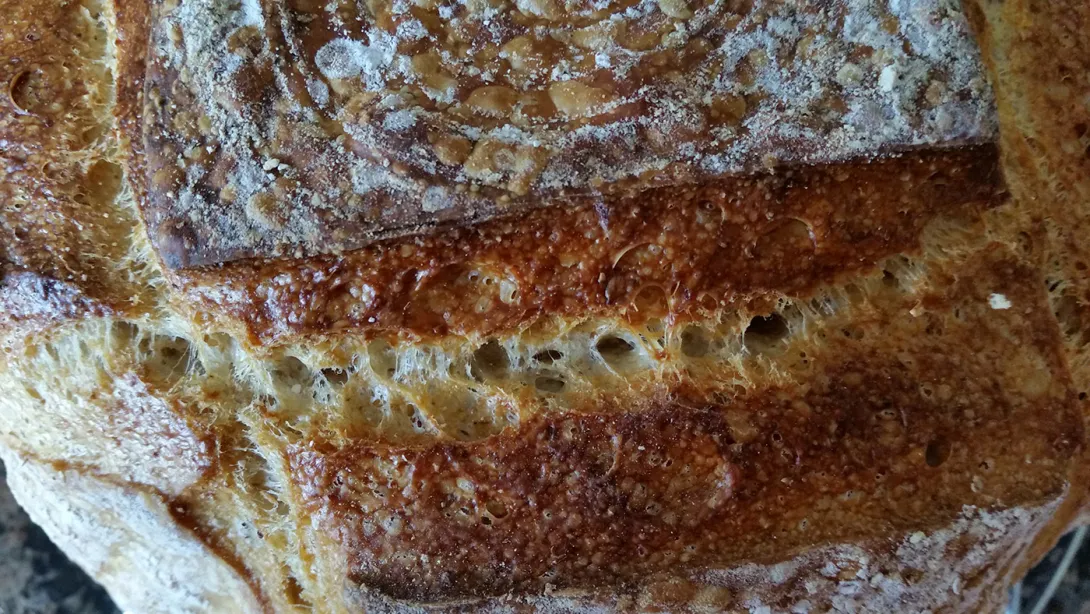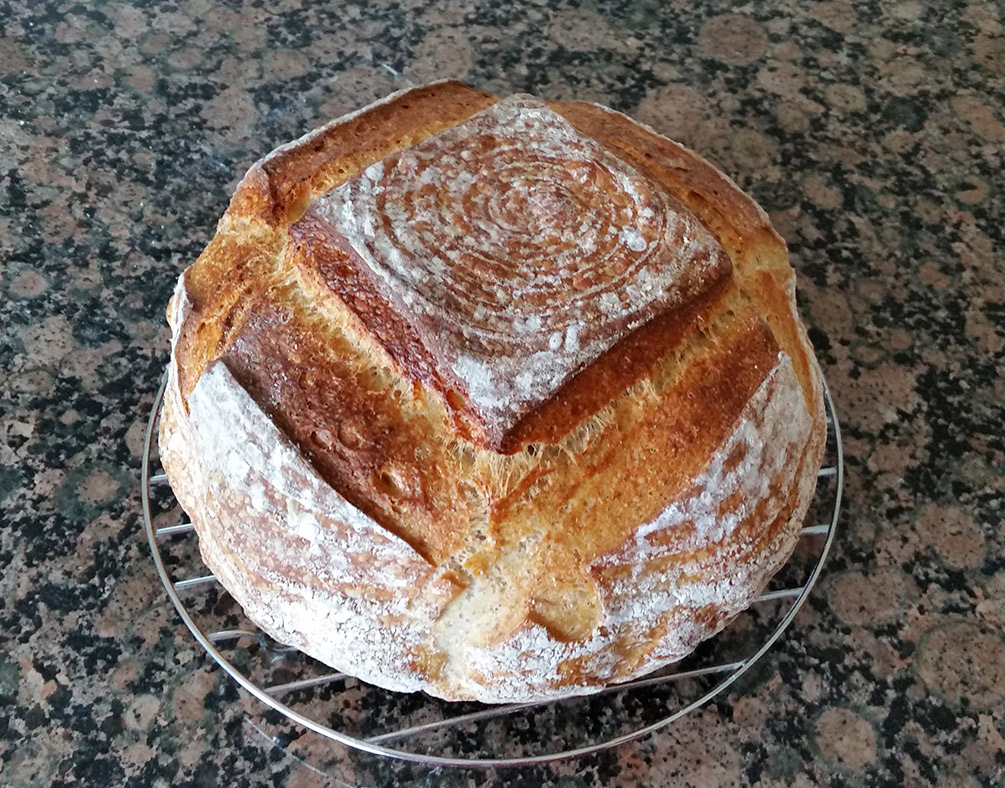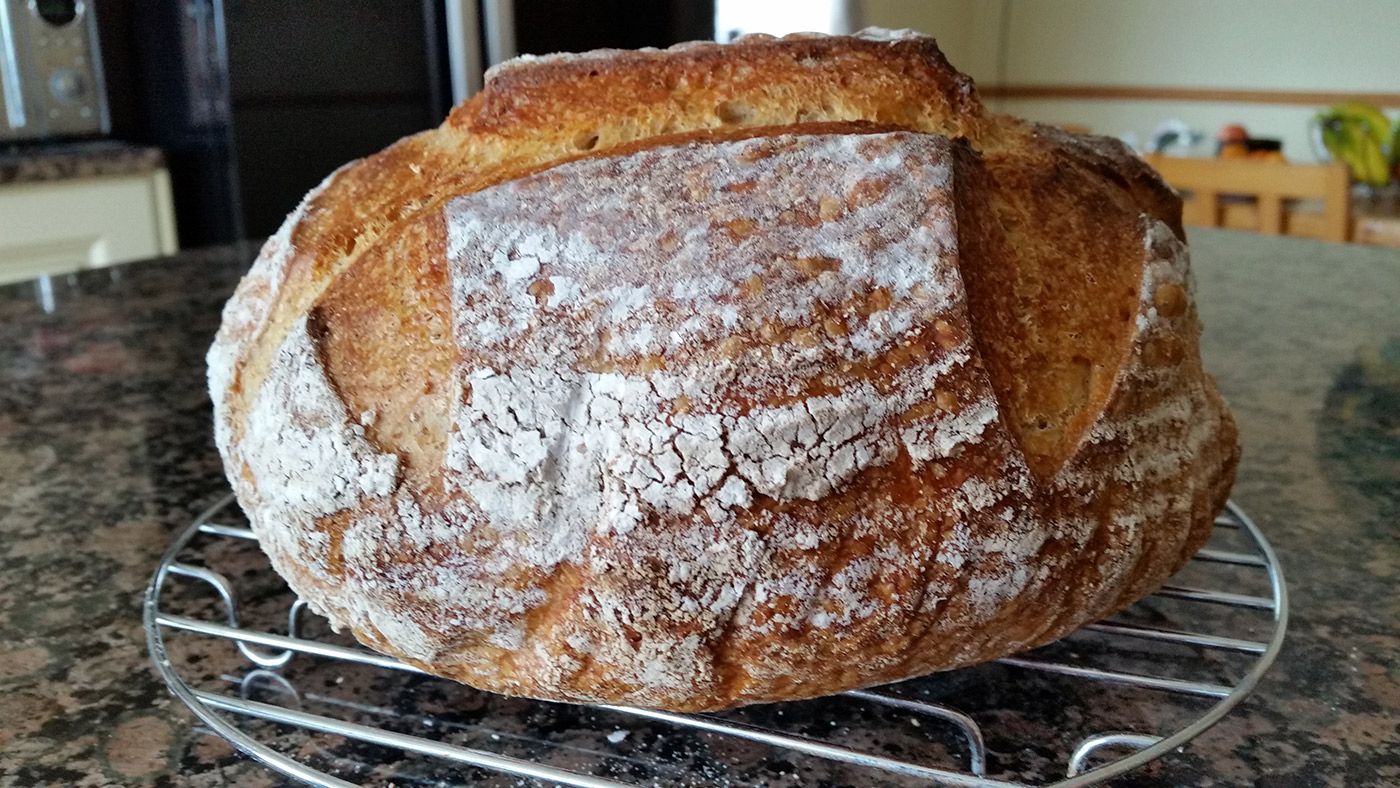


To me it was new to do the finall rise of the bread in the fridge, I usualy do it the other way round, I knead the dough
and put it in the fridge for 12 - 18 hours and then shape the cold dough and put it in the baneton, proof and bake.
This time I shaped the bread after 12 hours bulk fermenting at room temperature and then let the bread rise for baking in the fridge.
It was so much easier to score the loaf for starters.
30 minutes before I pulled the banneton out of the fridge I pre heated my oven * in which I had my Dutch Oven * to
250 C and put the cold shaped bread on parchment paper, scored it, put it in the hot dutch oven and baked.
It worked well.
This is just a simple recipe, nothing special but always yummy.
I changed the recipe slightly by using only 400g wheat flour and 200g wholewheat flour, usually I use 500g Wheat flour and 200g Whole wheat flour.
200 g mature 50% hydration wheat Starter
400g wheat flour
200g whole wheat flour
300g warm water
10g salt
2 Tbsp vegetable oil * I did not have olive oil in the house *
Mix all up, knead until soft , smooth and elastic dough , bulk ferment for 12 hours, shape the loaf, put it in the banneton, cover with floured kitchentowel and plastic bag, put in the fridge for finall rise and bake straight from the fridge after 12 hours * Over night *.
YUMMY
- PetraR's Blog
- Log in or register to post comments
Seems this method works great for you too. I tend to work using your old method. What mad you decide to change it up?
I started the bread yesterday morning at 11am, so after 12 hours bulk fermentation it was 11pm and I was tired.
Since I needed the bread quite quickl in the morning I just shaped it, put it in the banneton in the fridge so that I could bake it straight from the fridge, so to speak.
It worked great, scoring the bread was a doodle.
I shall carry on doing it like this.
Necessity is the mother of invention, or at least trying something new. Thanks for the information, I will have to give this a go and do a side-by-side.
I think both method work well, but this way it is very easy to score the bread and just bake it as cold as it is when it is out of the fridge.
Shall stick to this method:)
What I did though was , I floured a kitchen towel to put it over the banneton with the dough, I than put the banneton with the floured kitchen towel on yet another kitchen towel * that does not need to be floured * and foldet the left and right side of that kitchen towel also over the top of the banneton and only than I put it in the plastic bag, that way I did not have the condensation of the bag on the dough but only on the kitchen towel.
Works for me:)
is that you gain much more flexibility as to when you want to bake it - plus it makes the scoring a snap for really wet dough. Since the dough does most of its final proofing in the first few hours in the fridge before the dough can cool down enough to really slow down the reproductive rates of LAB and yeast, the proofing can be quite long afterwards. You can't get it it in 12 hours to bake no worries it won't change much at the 18 - 24 hour nark if the fridge is 36 F.
Baking cold dough also seems to promote blisters on high hydration dough as well. My favorite tasting breads are this with long cold bulk ferments and long cold shaped final proofs. Time and temperature are two of the most important attributes in making bread taste great.
Your bread came out just perfect and I bet the crumb was open and it tasted great as well. Glad you got the chance to try bread the non PR way -' the other way'- so you can take advantage of its benefits to changing baking schedules.
Well done and Happy baking
I totally agree, I was not aware how much easier it this way round.
So I could leave it in for up to 24 hours without worrieng that it spills over the banneton?
2 long cold proofs would be bulk fermenting in the fridge, than taking it out, shaping and proofing in the fridge?
I have to have a go with that one next weekend, to much baking to do for easter. pffff
What does PR stand for? Proofing Roomtemperature? Just guessing.
YES, I noticed the fine little blisters and the crumb is slighty different too in feel, hard to describe.
I start one bread in the morning and do the overnight proofing in the fridge again.
the famous Peter Reinhart uses and Ian Sandman also uses most always. I have found it to make for smaller holes.
Yes do a long bulk ferment in the fridge, take it out and shape it .....and then let it final proof in the fridge too. A total of 24 hours should be possible with the levain down around 10% here so 15% in Chilly Brittian or so. This seems to make for the best bread all around if you have the time
Happy baking
that depends on user comments to survive but then eats them so no one can see them..... out of spite it seems:-)
Yes PR is Perter Reinhart who uses the long cold bulk ferment followed by shaping and then a short room temp final proof . i much prefer the opposite. Short counter bulk ferment and then a long cold shaped final proof.
The best bread made around here has a long cold bulk ferment followed by a long cold shaped final proof - about 8-12 hours each. but yo have to have the time and cut back the levain to around 10% or so. Cold and time make for the best tasting SD bread.
Happy Baking
Ahhh, I understand.
Yes, I always did the long cold Bulk ferment and the short proofing at room temp.
I must say that I much prefer it the other way round , and the crust was heavenly:)
I shall try to cut back on the levain by 10% next time, right now I have one loaf proofing in the fridge to be baked tonight , ready for our dinner:)
Thank you so much for the info dabrownman.
Happy Baking to you to :)
If memory serves me right, I remember you live in a warmer climate as well. What would your room temperature be for your bulk fermentation (not cold bulk fermentation)? How long do you bulk ferment (if you live in that warmer/hot climate)?
Cheers,
Ingrid
Oh sorry, thought you where talking to me lol.
Petra: Really nice and turned out perfectly. I will have to try that scoring pattern. I have been experimenting with very long cold bulk fermentation times and then shaping and baking pretty quickly and other times shaping and then popping it back into the fridge overnight. In fact, that's what I will do tonight with dough I have had in the fridge for several days. I agree with dabrownman, too, that the scoring is much easier on a cold loaf and that two cold proofs really make a nice , tasty bread. Thanks for sharing. Best, Phyllis
So far I always did the bulk fermentation either 12 hours on the bench at room temperature , then shape, proofe for 2 hours and bake * That I call quick bread lol as all is done the same day *
I usually started the bread at about 9pm in the evening and put the dough in the fridge to bulk ferment to about midday the following day, than shape, proof and bake.
This way round is perfect though and I think i stick to it.
Starting the bread in the morning, bulk ferment at room temperature for 12 hours, shape, proof in fridge and bake it straight from the fridge.
I noticed a slight difference in feel of the crust and of cours all those tiny little blisters.
The soring really was easy on such a cold dough:)
I did not even need to use a lame, I just used my bread knife.
Wiith the cold dough going into the Dutch oven, do you still use the same baking time and lower temperature after 30 minutes?
No changes at all.
30 min. at 250 C with lid on, 20 min. at 200C with the lid off.:)
The dough is in the fridge for tomorrow morning's baking!
Cool!
Mine is in the fridge for tonight baking:)
I wanted some nice Sourdough bread with our dinner.
I make meatloaf but I am to lazy to make mash and vegetables so I serve it with sourdough bread and butter and Salad.
We have a day time temperature of 28º still and I thought I reduce the bulk fermentation time by three hours.
Result - my dough was under-proofed. I ignored the visual signs and went ahead with the final proof in the fridge overnight.
Should have put the banneton back into the fridge for another 12 hours, I think.
Never mind! The loaf looks very nicely scored but feels more like a brick.
Another day, another try!
Hmmm, if it is so hot during the day why do you not skip the bulk fermentation and just knead, shape, put in banneton and in the fridge?
I am lucky that we do not have such high temperatures, just in the Summer and even than not many days of heat. pheww
I think in the Summer I will forget about bulk fermentation, do a longer Autolyse, shape, banneton, fridge.